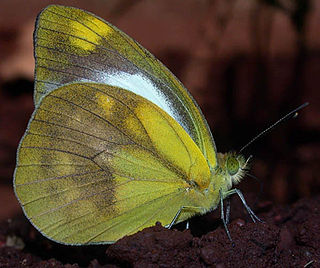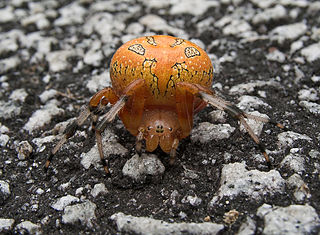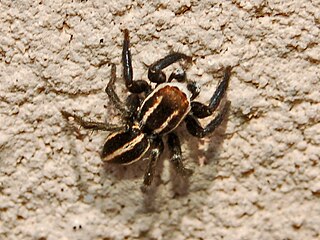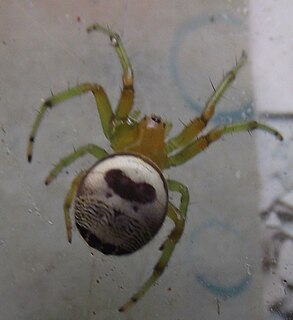
Cepora nadina, the lesser gull, is a small to medium-sized butterfly of the family Pieridae, that is, the yellows and whites. The species was first described by Hippolyte Lucas in 1852. It is native to Sri Lanka, India, Myanmar, Hainan, and southeast Asia.

Uloborus walckenaerius, also known as the feather-legged spider, is a cribellate spider in the family Uloboridae. Like all spiders in this family, they do not have venom glands and immobilize their prey with over 140 metres of thread. They are named in honor of Charles Athanase Walckenaer.

Oecobius navus is a small cosmopolitan cribellate spider species found across the world.

Alopecosa accentuata is a species of wolf spider found commonly in open habitats throughout continental Europe with a reported palearctic distribution. The female has a body length of up to 12 mm, the male is rather smaller at up to 9 mm. The name was at one time treated as a nomen dubium, but is now considered the correct name of Alopecosa barbipes.

Curetis bulis, the bright sunbeam, is a species of butterfly belonging to the lycaenid family. It is found in Asia.

Nymphalis xanthomelas, the scarce tortoiseshell, is a species of nymphalid butterfly found in eastern Europe and Asia. This butterfly is also referred as yellow-legged tortoiseshell or large tortoiseshell.

Araneus marmoreus, commonly called the marbled orbweaver, is a species of spider belonging to the family Araneidae. It is sometimes also called the pumpkin spider from the resemblance of the female's inflated abdomen to an orange pumpkin. It has a Holarctic distribution.
Spartaeus ellipticus is a species of jumping spiders found only in Taiwan. It has a total length of nearly 6 mm. The carapace is dark brown with paler markings towards the rear and a black margin. The whole carapace is densely covered with white hair. The legs are brown with many large, prominent spines. The oval abdomen is greyish brown marked overall with small dark patches.

Rugathodes sexpunctatus is a minute species of spider in the family Theridiidae, the cobweb or tangle-web spiders. This family includes the medically important genus Latrodectus—the widow spiders. The species in the genus Rugathodes are too small to be dangerous to humans. Very little is known about most species in this genus.

Menemerus bivittatus is a spider in the family Salticidae commonly known as the gray wall jumper. It is a pantropical species and is usually found on the walls of buildings or on tree trunks where it stalks its prey.

Neoscona domiciliorum, commonly known as the spotted orbweaver or redfemured spotted orbweaver, is a spider in the family Araneidae. The specific epithet domiciliorum means "of dwellings" in Latin and refers to the fact that this species is often found living on buildings. Their bites are not known to cause serious harm in humans.

Phlegra bresnieri is a species of jumping spiders. Its specific name bresnieri honors the 19th-century French Arabist Louis-Jacques Bresnier.

Araneus mitificus, commonly known as the kidney garden spider or pale orb weaver is a species of orb-weaver spider found in South, East, and Southeast Asia.

Attulus inexpectus is a species of spider from family Salticidae, found in from Europe to central Asia. It was previously misidentified as Attulus rupicola.

Ero cambridgei is a pirate spider species with Palearctic distribution. It is notably found in Lithuania.

Hyptiotes paradoxus, also known as the triangle spider, is a cribellate orbweaver in the family Uloboridae.

Menemerus semilimbatus is a spider in the family Salticidae.

Avicularia juruensis is a species of spider in the family Theraphosidae, found in South America. Avicularia urticans was brought into synonymy in 2017. It has been given the English name Amazonian pink toe spider. Under the synonym Avicularia urticans, it is also known as the Peruvian pinktoe tarantula. It is a large mygalomorph spider, with a maximum body length over 30 mm (1.2 in) and the longest fully extended leg about 60 mm (2.4 in). Like other species in the genus Avicularia, specimens under this name are sold as pets, although their identity has not been confirmed by taxonomic studies.

Dicromantispa sayi is a species of mantidfly in the family Mantispidae. It is found in the Caribbean Sea, Central America, and North America.

Plexippus petersi is a species of jumping spider native to Asia and has been introduced to Africa and Pacific islands. The male is between 6 and 10 mm in length, and the female is around 10 millimetres (0.4 in). This spider is commonly known as the tropical flycatcher or small zebra jumper.




















